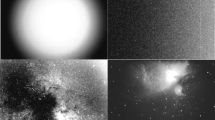Abstract
The article is devoted to developing a compression method using context modeling of a sequence of bits and wavelet transform, which make it possible to take into account the specifics and properties of the initial hyperspectral remote sensing data. Two algorithms for compressing hyperspectral data (lossy and lossless) based on wavelet transform are proposed, the distinguishing features of which are reduction in the required memory size, acceleration of the search for significant wavelet coefficients using a pyramid with approximating coefficients, and an increase in the compression coefficient. Recommendations for applying these algorithms are formulated. A distinctive feature of the hyperspectral data compression method is the ability to control the compression coefficient owing to parametric adjustment of the algorithms, application of context modeling and adaptation to the type of initial data (classical cube or Fourier interferogram). The efficiency of the technique has been experimentally confirmed using examples of compression of classical data and real Fourier interferograms with compression ratios of 4.1 and 2.4, corresponding to the level of the best global results, as well as analytically with data distortion in a compressed stream.






Similar content being viewed by others
REFERENCES
CASI-1500 [Electronic Resource] / ITRES. Available at: http://www.itres.com/casi-1500/ (Accessed November 11, 2018).
AVIRIS Hyperspectral Images [Electronic Resource] / Jet Propulsion Laboratory, California Institute of Technology. Available at: http://aviris.jpl.nasa.gov/data/free_data.html (Accessed September 10, 2016).
F. Rizzo, B. Carpentieri, G. Motta, and J. A. Storer, “Low-complexity lossless compression of hyperspectral imagery via linear prediction,” IEEE Signal Process. Lett. 12 (2), 138–141 (2005).
M. Klimesh, Low-complexity lossless compression of hyperspectral imagery via adaptive filtering, Technical Report 42–163 (Jet Propulsion Laboratory, California Institute of Technology, 2005).
R. Pizzolante, “Lossless compression of hyperspectral imagery,” in Proc. First International Conference on Data Compression, Communications and Processing (CCP 2011) (Palinuro, Italy, 2011), IEEE Computer Society, pp. 157–162.
H. Wang, S. D. Babacan, and K. Sayood, “Lossless hyperspectral-image compression using context-based conditional average,” IEEE Trans. Geosci. Remote Sens. 45 (12), 4187–4193 (2007).
E. Magli, G. Olmo, and E. Quacchio, “Optimized onboard lossless and near-lossless compression of hyperspectral data using CALIC,” IEEE Geosci. Remote Sens. Lett. 1 (1), 21–25 (2004).
J. Mielikainen, “Lossless compression of hyperspectral images using lookup tables,” IEEE Signal Process. Lett. 13 (3), 157–160 (2006).
J. Mielikainen and P. Toivanen, “Lossless compression of hyperspectral images using a quantized index to lookup tables,” IEEE Geosci. Remote Sens. Lett. 5 (3), 474–478 (2008).
X. Tang and W. A. Pearlman, “Three-dimensional wavelet-based compression of hyperspectral images,” in Hyperspectral Data Compression, Ed. by G. Motta, F. Rizzo, and J. A. Storer (Springer, Boston, MA, 2006), pp. 273–308.
E. Christophe, “Hyperspectral data compression tradeoff,” in Optical Remote Sensing, Ed. by S. Prasad, L. Bruce, and J. Chanussot, Augmented Vision and Reality (Springer, Berlin, Heidelberg, 2011), Vol. 3, pp. 9–29.
M. A. Engin and B. Cavusoglu, “New approach in image compression: 3D spiral JPEG,” IEEE Commun. Lett. 15 (11), 1234–1236 (2011).
J. Gada, QM Coder [Electronic Resource]. Available at: https://github.com/jigar23/CABAC/blob/master/CABAC/HW2_Report_bac.pdf (Accessed September 10, 2018).
Funding
This work was partially supported by the Belarusian Republican Foundation for Basic Research (project No. F18V-005) and the State Committee for Science and Technology of the Republic of Belarus (project No. F18PLSHG-008P).
Author information
Authors and Affiliations
Corresponding authors
Ethics declarations
COMPLIANCE WITH ETHICAL STANDARDS
This study does not contain any research involving humans or animals as research objects.
CONFLICT OF INTEREST
The authors declare that they have no conflict of interest.
Additional information

Pertsau Dmitry Yuryevich. Born August 31, 1987. Graduated from Belarusian State University of Informatics and Radio Electronics (BSUIR), Department of Computer Systems and Networks, Minsk, Belarus, 2010. Received a master’s degree in Computing Machines and Systems, BSUIR, Minsk, Belarus, 2011. Postgraduate studies in specialty “Computers, Complexes and Computer Networks” at BSUIR, Minsk, Belarus, 2012–2016.
Senior lecturer at BSUIR. Areas of scientific interest: image processing and pattern recognition in computer vision systems, remote sensing image processing. Author of 25 scientific papers, including 6 articles.

Doudkin Alexander Arsentyevich. Born October 13, 1950. Graduated Department of Physics and Mathematics, Vitebsk State Pedagogical Institute in 1972. Head of Laboratory for System Identification, UIIP NAS of Belarus, Professor of Computer Department, BSUIR. Dr. Eng. (2010), Prof. (2016).
Areas of scientific interest: digital signal and image processing; pattern recognition; architectures and models of computer vision systems and high-performance processing. Author of more than 300 scientific papers, including 3 monographs and 90 articles.
Membership in scientific societies: member Belarusian Society for Operations Research, Belarusian branches of international society of neural networks, and Belarusian Association for Image Analysis and Recognition. Chairman of the organizing committees of international conferences “Pattern Recognition and Information Processing” (PRIP’1999, PRIP’2005, PRIP’2011), “Neural Networks and Artificial Intelligence” (ICNNAI’01, ICNNAI, 03, ICNNAI’08, ICNNAI’12), member of international program committees of PRIP conferences, ICNNAI, IEEE International Conference on Intelligent Data Acquisition and Advanced Computing Systems: Technology and Applications”(IDAACS), Neuroinformatics.
Member of editorial boards of: Journal of Research and Applications in Agricultural Engineering (Poland) and Journal of Belarusian State University: Mathematics, Informatics.
Rights and permissions
About this article
Cite this article
Pertsau, D.Y., Doudkin, A.A. Context Modeling in Problems of Compressing Hyperspectral Remote Sensing Data. Pattern Recognit. Image Anal. 30, 217–223 (2020). https://doi.org/10.1134/S1054661820020121
Received:
Revised:
Accepted:
Published:
Issue Date:
DOI: https://doi.org/10.1134/S1054661820020121




